 Imperial measurements were once used worldwide, but now have mostly been superceded by the Metric system, which is far easier to use. Instead of having to memorize a series of conversions like 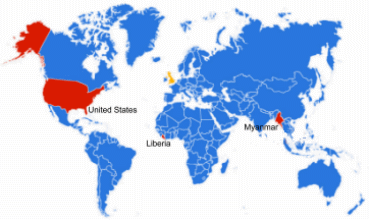 Despite the difficulty involved in using Imperial units, it's still necessary that we use them. Even though just about every country in the world now uses metric units, including Canada, there are still a few that irrationally cling to the Imperial system, as you can see in red on the map at the right.
Despite the difficulty involved in using Imperial units, it's still necessary that we use them. Even though just about every country in the world now uses metric units, including Canada, there are still a few that irrationally cling to the Imperial system, as you can see in red on the map at the right. The few countries that stubbornly refuse to enter the The fact that the United States is still using the Imperial system is the problem. Because they are such an economic and technological powerhouse and important trading partners with most of the world, including Canada, we have no choice but to be familiar with Imperial units. Their lumber is measured in board feet. Machine parts are in inches and fractions of an inch. So are the specs for vehicles made in the U.S. If we travel there, we need to know about miles. Because of this unfortunate fact, many school systems in Canada now deem it necessary to include a Unit where students can learn about Imperial units. In Alberta, this happens in Grade 10 math.  Strangely, despite the fact that Canada has been using the Metric system for decades, and students in school until recently have grown up with it, knowing nothing else, there are still a few places where Imperial units have always been used.
Strangely, despite the fact that Canada has been using the Metric system for decades, and students in school until recently have grown up with it, knowing nothing else, there are still a few places where Imperial units have always been used. One such place is in agriculture and land use. Farms are divided into sections and quarter sections, with the area covered measured in acres. A section is one mile long; a quarter-section a half mile long. An acre is 43,560 square feet. So let's have a look at Imperial distance units. 1 Yard The base unit is the yard. A yard is similar in length to a metre, just a little bit shorter.  
A yard is 36 inches long. (A metre is about 39 inches). A yard is roughly the height of an average 4-year old. In sports, a hundred metre dash is equivalent to about 109 yards, so 100 yards is shorter. However, the Olympics (and competitive sports in general) have used the metric system since 1896. One yard is exactly 36 inches long. 1 Foot 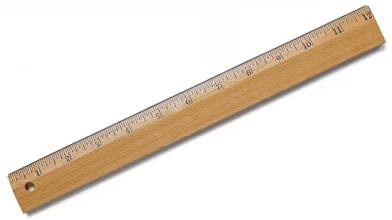 A standard ruler is one foot, or 12 inches. In Canada rulers also show Metric units, so a ruler also shows about 30 centimetres.
A standard ruler is one foot, or 12 inches. In Canada rulers also show Metric units, so a ruler also shows about 30 centimetres.
In Canada, a one litre bottle of pop is about one foot tall. A foot is 12 inches. Since a yard is 36 inches long, there are 3 feet in a yard. An Imperial foot is not the length of your foot, although it might be close. 1 Inch 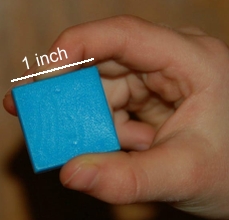 An inch is roughly the length of the first joint on an adult's thumb.
An inch is roughly the length of the first joint on an adult's thumb.There are 12 inches in a foot, and 36 inches in a yard. Divisions smaller than an inch don't have names, but are described as fractions of an inch. 
Using the Imperial system means that you may have to work with fractions. For example, if you cut a piece that's You'll have to subtract 5 3/4 from 11 1/3. Here's the calculation:  Just one more reason why the Imperial system is unpleasant to use. Carpenters, for example, will work with all of these fractions: 
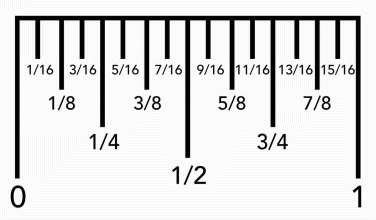 1 Mile 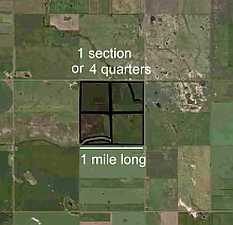 It takes the average person 15-22 minutes to walk one mile.
It takes the average person 15-22 minutes to walk one mile. A mile is about 1.6 kilometres. 1 mile = 5280 feet 1 mile = 1760 yards 60 miles per hour is about 100 kilometres per hour If your speed is 100 km/h, it will take about 1 minute to travel 1 mile Conversions We're just going to look at simple Imperial to Imperial conversions. The usual method used in the classroom is to make use of a table of conversion factors. When a special calculator isn't available, this is the method most often used in real-world trades. For example,how many inches are in 37 feet? Multiply 37 x 12 = 444 You'll also need to use ratios: 
Once again, here are the conversion factors you'll need: It's worth pointing out that with all other units in the Imperial system besides distance, the conversion numbers are different for each. For example: Mass: 1 ton = 2000 pounds 1 pound = 16 ounces Volume: 1 gallon = 4 quarts 1 quart = 2 pints 1 pint = 20 fluid ounces 1 quart = 40 fl ounces In the Metric system, however, the conversions are always multiples of ten. |